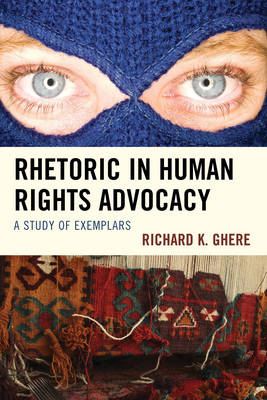
Rhetoric in Human Rights Advocacy
A Study of Exemplars
Seiten
2015
Lexington Books (Verlag)
978-0-7391-9393-8 (ISBN)
Lexington Books (Verlag)
978-0-7391-9393-8 (ISBN)
This book explores the argumentative strategies used in various human rights contexts by those who advance advocacy rhetoric. Twelve case studies focus on the rhetoric of individuals or groups who work for or against human rights, offering insights about effective argumentative strategies used either to advance or obstruct human rights causes.
This book examines the rhetoric of various “exemplars” who advocate for causes and actions pertaining to human rights in particular contexts. Although some of these exemplars champion human rights, others are human rights antagonists. Simply put, the argument here is that concern for how particular individuals advocate for human rights causes—as well as how antagonists obstruct such initiatives—adds significant value to understanding the successes and failures of human rights efforts in particular cultural and national contexts.
On one hand, we can grasp how specific international organizations and actors function to develop norms (for example, the rights of the child) and how rights are subsequently articulated in universal declarations and formal codes. But on the other, it becomes apparent that the actual meaning of those rights mutate when “accepted” within particular cultures. A complementary facet of this argument relates to the centrality of rhetoric in observing how rights advocates function in practice; specifically, rhetoric focuses upon the art of argumentation and the various strategies and techniques enlisted therein. In that much of the “reality” surrounding human rights (from the standpoints of advocates and antagonists alike) is fundamentally interpretive, rhetorical (or argumentative) skill is of vital importance for advocates as competent pragma-dialecticians in presenting the case that a rights ideal can enhance life in a culture predisposed to reject that ideal.
This book includes case studies focusing on the rhetoric of the following individuals or groups as either human rights advocates or antagonists: Mary B. Anderson, Rwandan “hate radio” broadcasters, politicians and military officials connected with the Kent State University and Tiananmen Square student protest tragedies, Iqbal Masih, Pussy Riot, Lyndon Johnson, Julian Assange, Geert Wilders, Daniel Barenboim, Joe Arpaio, and Lucius Banda.
This book examines the rhetoric of various “exemplars” who advocate for causes and actions pertaining to human rights in particular contexts. Although some of these exemplars champion human rights, others are human rights antagonists. Simply put, the argument here is that concern for how particular individuals advocate for human rights causes—as well as how antagonists obstruct such initiatives—adds significant value to understanding the successes and failures of human rights efforts in particular cultural and national contexts.
On one hand, we can grasp how specific international organizations and actors function to develop norms (for example, the rights of the child) and how rights are subsequently articulated in universal declarations and formal codes. But on the other, it becomes apparent that the actual meaning of those rights mutate when “accepted” within particular cultures. A complementary facet of this argument relates to the centrality of rhetoric in observing how rights advocates function in practice; specifically, rhetoric focuses upon the art of argumentation and the various strategies and techniques enlisted therein. In that much of the “reality” surrounding human rights (from the standpoints of advocates and antagonists alike) is fundamentally interpretive, rhetorical (or argumentative) skill is of vital importance for advocates as competent pragma-dialecticians in presenting the case that a rights ideal can enhance life in a culture predisposed to reject that ideal.
This book includes case studies focusing on the rhetoric of the following individuals or groups as either human rights advocates or antagonists: Mary B. Anderson, Rwandan “hate radio” broadcasters, politicians and military officials connected with the Kent State University and Tiananmen Square student protest tragedies, Iqbal Masih, Pussy Riot, Lyndon Johnson, Julian Assange, Geert Wilders, Daniel Barenboim, Joe Arpaio, and Lucius Banda.
Richard K. Ghere is associate professor at the University of Dayton where he is a researcher in the Human Rights Center.
1 Introduction: Rhetoric and Human Rights Advocacy
2 Advocacy Rhetoric through Thick and Thin: A Conceptual Backdrop
3 Rhetoric in Moral Crises
4 Rhetoric in Moral Confrontations
5 Rhetoric in Moral Projects
6 Rhetoric in Moral Work
7 Dialectical Human Rights Advocacy
| Co-Autor | Youssef Farhat |
|---|---|
| Verlagsort | Lanham, MD |
| Sprache | englisch |
| Maße | 161 x 235 mm |
| Gewicht | 531 g |
| Themenwelt | Sozialwissenschaften ► Kommunikation / Medien ► Kommunikationswissenschaft |
| Sozialwissenschaften ► Politik / Verwaltung ► Europäische / Internationale Politik | |
| Sozialwissenschaften ► Politik / Verwaltung ► Politische Systeme | |
| Sozialwissenschaften ► Politik / Verwaltung ► Staat / Verwaltung | |
| ISBN-10 | 0-7391-9393-7 / 0739193937 |
| ISBN-13 | 978-0-7391-9393-8 / 9780739193938 |
| Zustand | Neuware |
| Haben Sie eine Frage zum Produkt? |
Mehr entdecken
aus dem Bereich
aus dem Bereich
Eine Einführung
Buch | Softcover (2022)
Springer VS (Verlag)
CHF 39,15
Buch | Softcover (2024)
Springer Gabler (Verlag)
CHF 69,95


